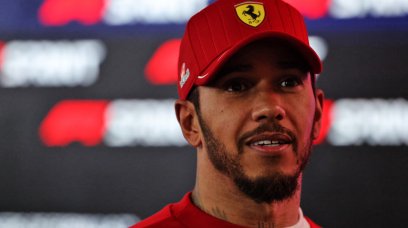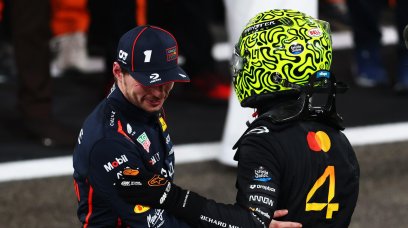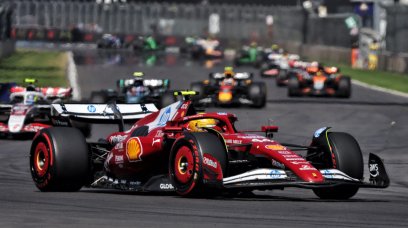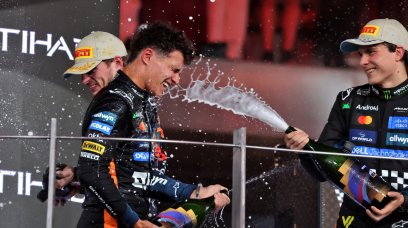The famously unpredictable weather at the Interlagos circuit had once again wreaked havoc at the Brazilian Grand Prix, but little did spectators know that the 2003 edition would be one of the most bemusing of all time. After delays, the race underwent a rolling Safety Car start, which hadn't yet become a common sight for wet Formula 1 races, with Ferrari's home hero Rubens Barrichello leading the field from McLaren's David Coulthard, Jaguar's young hotshot Mark Webber, and McLaren's new 'Flying Finn' Kimi Raikkonen. Reigning World Champion Michael Schumacher started from P7, just ahead of the day's unexpected hero Giancarlo Fisichella, driving for a Jordan team which had fallen on hard times and hoped for merely a points finish. Fisichella describes to RacingNews365 the treacherous, unpredictable conditions facing the drivers that day, particularly at the downhill left-hander of Turn 3: "It was raining very heavily until the end of the race, it was so difficult because the rain was very inconsistent, and lap after lap, there were different conditions on the circuit. Sometimes there was less water, then two laps later there was more water. "In Turn 2 and Turn 3 there was a big river, sometimes it was bigger than normal and there was aquaplaning. "I remember a couple of times I lost the control of the car, especially with the rear end, but I was lucky to keep the car on the road. It was so inconsistent. "It was important a few metres before this river to slow down a bit, otherwise there was aquaplaning, and it was impossible to keep control of the car."
Formula 1's elite fall foul of sodden conditions
Several drivers were caught out by the conditions at Turn 3, including then-five-time World Champion Schumacher, 2009 champion Jenson Button, Juan Pablo Montoya and wet-weather specialist Jos Verstappen, who all ploughed into the barriers on the outside of the corner. With the scrap pile of Formula 1 cars mounting up and pole-sitter Rubens Barrichello – who was looking to end his winless curse on home soil – retiring from the race, the top three was whittled down to the two McLarens of David Coulthard and Kimi Raikkonen, and Fisichella. The plucky Jordan team, masters of adverse Grand Prix racing scenarios, were fully prepared to take advantage of a rare opportunity. An early pit-stop under the Safety Car allowed the Jordan team to refuel their car, run long into the race and make a bold prediction on the race duration, something which team boss Eddie Jordan credits to their long-time designer and technical guru Gary Anderson. "It was very clear that the weather was closing in on us. In our minds, there was no way it was going to get to the end of the race," told RacingNews365 . "It was getting dark, it was torrential rain, and then there's all this action, and so at our pit-stop we had planned to give us just enough fuel to get us to three-quarter distance. "Gary was brilliant at things like this: He said that they will stop the race one lap after the 75% distance [required for awarding full points], and that's exactly what happened." With Coulthard pitting from P1 on Lap 52 of 71, this left Fisichella, who was having one of the performances of his F1 career, to challenge and pass Raikkonen for the lead, forcing the Finn into a mistake at Mergulho corner (Turn 11). "It was so difficult to keep the car on the road, but I was so comfortable," said Fisichella. "I was quite happy with the set-up and was pushing, but at the same time also paying a lot of attention to these difficult corners. "It was a difficult race, but I was catching all of them, and I overtook a lot of people, and by the time I overtook Kimi Raikkonen, we had the red flag."
Huge accident sparks red flag puzzle
Whilst the event will be remembered for its post-race bemusement, the bizarre conclusion to the race was triggered by one of the biggest crashes of the season, involving Webber and Fernando Alonso, who was making only his 19th F1 start and had only taken his first podium at the previous round in Malaysia. In contention for a points haul, Webber had lost control of his car on the curved, cambered Arquibancadas corner, which is traditionally an unnoticeable, full-throttle turn in dry conditions, but becomes a completely different challenge in wet conditions. His collision with the outside wall scattered debris from his car across the track, with Alonso – who approached the incident close to full speed, colliding with one of Webber's wheels and having his own accident of equal magnitude – triggering the red flags. Webber recalled Alonso's impact speeds, which he believes came as a result of the Renault driver trying to negotiate an advantage with a possible Safety Car period. "It was a brilliant, brilliant Grand Prix for me up until that point. It was a big hit, and then when Fernando come in after me, it was like a bomb going off when he came in," Webber told RacingNews365 . "His radio around 10 seconds before that would have been, 'Fernando, push, we're gonna pit and do something,' because back then as soon as you saw yellow flags, you pushed! "So he comes over a blind crest - people don't see the trajectory, you can't see f*** all, and our eyes are kneecap height - and when Fernando popped over the top, he's come across my debris. "Of course, I was worried for him. I was groggy, but I got out over the fence and I thought, 'That's a red flag.' The last sector looked like it had just been hit by missile or something. The two cars had just been absolutely obliterated, and so had the tyre barriers." Alonso was taken to hospital for precautionary checks, but both drivers emerged unscathed, with Webber going above and beyond to prove his wellbeing to the medical team. "They said, 'Oh, you must be sore,' but I remember I did 60 press-ups in the physio room afterwards to show them that I was fine!"
Pit lane fires and podium confusion
Under the regulations, a race being red-flagged after 75% distance means that the race would not resume, and the results would be taken two laps prior to the red flags being shown, prompting much debate between Fisichella and the Jordan team. "During the in-lap I was talking with [the] engineers, and they were telling me maybe they will stop the race, maybe it's the end of the race, or maybe we'll do another restart. But, if it's the end of the race, we are probably the winner," said Fisichella. “Then just by the end of the in-lap, when I was going to the pit lane, they told me, 'You’re the winner, it’s a red flag, the race is over and you are the winner!'" The Jordan team were convinced that they had taken their fourth Grand Prix win and, as Fisichella returned to the pits to enter parc fermé, the traditional car-and-driver victory shots were spoiled by the unusual scenes of the race-winning car catching fire, something which Fisichella blames on a slow in-lap. "We didn't know if the race was still going on, if there would be a problem with engine. Probably because I was going quite slowly on the in-lap after the red flag, the water temperature was going crazy. This was probably the problem. I'm sure if the race was still on, there was no problem at all." Further confusion followed. News began to filter through that Raikkonen was to be declared the winner. The stewards believed that Fisichella had been on his 55th lap of the race when the red flag conditions began, and applied the countback rule to declare the result of the race from Lap 53, when Raikkonen was still in the lead. Elation turned to despair, and with the stewards and race control undeterred by Jordan's protests, the result was declared, and a visibly irked Fisichella stood in disbelief on the rostrum to collect what would have been his 10th Formula 1 podium without a victory. "It was a strange podium, because there were two of us, not three. Fernando was third, but he was in the hospital. So, on the podium was just myself and then Kimi," said Fisichella. "If before the race you asked me, 'Would you be happy if you finished second today?' Of course, I would have been happy, but, inside me and with the team, we were sure we were the winners. "On the podium, I was happy, but also a little bit angry because we thought we had won the race already."
Jordan: I had to make sure justice was done
Jordan and Fisichella were convinced that they were the true winners. With insufficient time after the race to protest the result, Jordan explained the timekeeping error which would only come to light several days after the race. "There was total confusion," recalled Jordan. "The timekeepers had it planned in that at the end of a red-flagged race, it had to countback. The problem is that [then Race Director] Charlie Whiting had rung the timekeepers and said, 'Guys, do not forget to make sure that you go back a lap.' "So they went back a lap on a programme which had already taken the countback into account. So, in actual fact it went back [an additional lap more]. "No matter how much I protested, with people like [then Deputy Race Director] Herbie Blash and Whiting, the podium was the podium. We were given second place." With Jordan convinced that Fisichella had started the 56th lap (and therefore should be the official winner on countback due to leading on Lap 54), the result was overturned by the FIA five days after the race had finished. "We had to go to Paris to the FIA appeal, and a number of people were telling me to drop it, including [then FIA President] Max [Mosley]. I always had a feeling that when Max tells you to drop something, then there's some form of an ulterior motive," added Jordan. "He didn't want any backlash on the FIA, which is understandable, but I had to see that justice was done. But then he was a lawyer, he was fair, and he understood. "When you think about it, at least the FIA looked at the situation, realised that a mistake was made, not by themselves personally, but a mistake was made, which is perfectly understandable, and at least they rectified it."
Imola celebrations
Awaiting the verdict from the FIA hearing, Fisichella recounted the moment he received the call from Jordan to confirm his first Formula 1 victory: "I was at an important event for a sponsor of Jordan in Italy. Eddie Jordan called me directly and he said, 'Giancarlo, you’re the winner, definitely. Now you are the winner!' So, I announced it to all of the people in front of me, it was fantastic. "We bought a couple of bottles of champagne! Then I went back home to my family, I opened a bottle of wine, and I celebrated the victory with my family. But, it was quite frustrating to not celebrate it on the podium." Ever the shrewd businessman, Jordan's attentions turned onto important matters for the team: "They said that they were going to get [McLaren Team Principal] Ron Dennis to bring the trophy to the next race and swap it over. "Of course, I then think, ‘Oh s***, we've lost the opportunity of being on the top of the podium, we've lost the possibility of the national anthems, and we've lost the possibilities for the sponsors' and things like that." A trophy handover ceremony was arranged at the San Marino Grand Prix, with the McLaren and Jordan cars wheeled out onto the main straight, and Raikkonen posed for pictures with Fisichella as he handed the trophy over.
Jordan's - and Ford's - last day in the sun
For Fisichella, it was a timely reminder of his abilities which helped reenergise his career. A move to Sauber was followed by a switch to Renault for 2005, where he rightly became one of Formula 1's frontrunners. Two further F1 victories were eventually followed by a moves to Force India and to Ferrari, the latter of which led to a career in endurance racing and class victories at the 24 Hours of Le Mans. For engine supplier Ford – who will return as a technical partner with Red Bull for 2026 – it was a rare highlight in an otherwise forgettable attempt at Formula 1 racing. The Blue Oval's 'full works' effort with Jaguar yielded two podiums in five seasons before they sold the team to Red Bull in 2005. But did they take some satisfaction from achieving a victory with the Jordan team in 2003? "They were furious, they were upset," said Jordan of Ford's reaction to the Brazil win. "I'd won for them, but do I think they were gracious to me? No. Everything they had was going towards Jaguar, and we were a little bit of a thorn in their side because we were able to do things that they weren't able to do. "For the money I was paying, I just thought that they could have been that much more generous. But Ford were never generous to Jordan, except in our very first year in 1991 when they gave us engines, and I suppose they didn't have to, but we paid for them of course." However, for the Jordan team - on their 200th GP - it was one of their final moments in the spotlight, with only one final podium coming at the farcical 2005 US Grand Prix before the team was sold at the end of that year. "It was very difficult, because there were difficulties with tobacco [sponsorship laws], and there were difficulties with sponsors," Jordan summarised. "A couple of years later, we sold to what eventually became the Force India team, and I'd realised at that stage that I wasn't in a position where I would be able to continue with the team."
Most read







